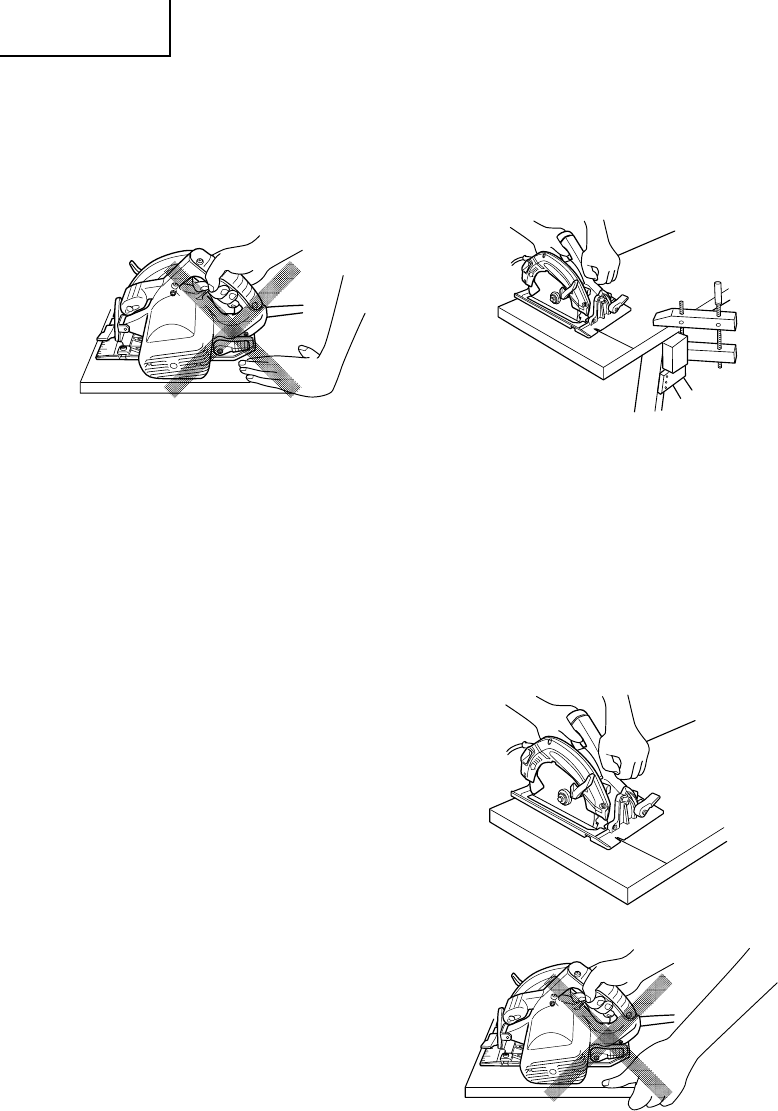
English
6
16. Use extra caution when making a “Plunge Cut”
into existing walls or other blind areas.
The protruding blade may cut objects that can
cause KICKBACK.
NEVER place your hand or fingers behind the saw.
If kickback occurs, the saw could easily jump
backwards over your hand, possibly causing
severe injury.
17. Check lower guard for proper closing before each
use. Do not operate the saw if lower guard does
not move freely and close instantly. Never clamp
or tie the lower guard into the open position.
If saw is accidentally dropped, lower guard may
be bent.
Raise the lower guard with the Retracting Handle
and make sure it moves freely and does not touch
the blade or any other part, in all angles and depths
of cut.
18. Check the operation of the lower guard spring. If
the guard and the spring are not operating
properly, they must be serviced before use.
Lower guard may operate sluggishly due to
damaged parts, gummy deposits, or a build-up of
debris.
19. Lower guard should be retracted manually only
for special cuts such as “Plunge Cuts” and
“Compound Cuts.” Raise lower guard by
Retracting Handle and as soon as blade enters the
material, the lower guard must be released.
For all other sawing, the lower guard should
operate automatically.
20. Always observe that the lower guard is covering
the blade before placing saw down on bench or
floor.
An unprotected, coasting blade will cause the saw
to walk backwards, cutting whatever is in its path.
Be aware of the time it takes for the blade to stop
after switch is released.
21. Adjustments. Before cutting be sure depth and
bevel adjustments are tight.
22. Avoid cutting nails. Inspect for and remove all nails
from work piece before cutting.
23. When operating the saw, keep the cord away from
the cutting area and position it so that it will not
be caught on the workpiece during the cutting
operation.
Operate with proper hand support, proper
workpiece support, and supply cord routing away
from the work area.
WARNING: It is important to support the work
piece properly and to hold the saw firmly to prevent
loss of control which could cause personal injury.
Fig. 4 illustrates typical hand support of the saw.
Fig. 6
Fig. 5
Fig. 3
A TYPICAL ILLUSTRATION OF
PROPER HAND SUPPORT
WORKPIECE SUPPORT,
AND SUPPLY CORD ROUTING.
Fig. 4
24. Place the wider portion of the saw base on that
part of the work piece which is solidly supported,
not on the section that will fall off when the cut is
made.
As examples, Fig. 5 illustrates the RIGHT way to
cut off the end of board, and Fig. 6 the WRONG
way. If the work piece is short or small, clamp it
down.
DON’T TRY TO HOLD SHORT PLACES BY HAND!
01Eng_C7ST_US 2/14/11, 11:106


















